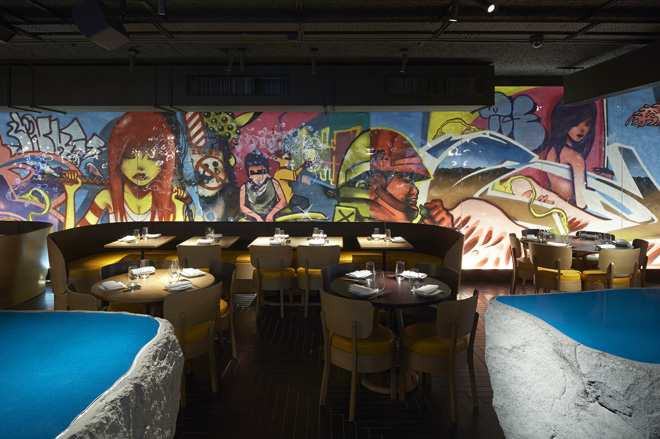Responsible for creating and evolving some of London’s most popular restaurants – among them ISOLA and MASH – Andy Martin Architects (AMA) has now transformed the interior of an imposing 1960’s building on London’s Frith Street into an inspiring Japanese restaurant.
The client’s central ambition was to give a younger market access to a quality product that was both affordable and aspiring. As such, the brief was to create a highly individual space that would combine a degree of sophistication with a more ‘underground’ feel.
During a trip to Tokyo, AMA conducted extensive research into the qualities of modern Japanese cuisine. “I wanted to create a truly sumptuous atmosphere without the stereotypical visual references,” says AMA’s Andy Martin. “We looked at the contrast that exists between traditional and contemporary Japanese culture, and this duality that exists between the two, and have tried to integrate that sense into our design.
“I”think the trip to Tokyo gave me the confidence to depart from the traditional references.”
The space itself offers a 450m² dining space, including a 100m² bar area, with some external dining space along the Frith Street frontage. Access to the restaurant is via a formal entrance off the street, leading into a reception lobby where guests can either enter the bar and sushi bar, or reach the first floor restaurant via a spiral staircase.
What is perhaps most striking about the restaurant’s interior is the dramatic sense of layering AMA has forged through the vast array of graphic wall panels, graffiti-abused interventions and artistic signals.
Street art is protected behind bespoke cast glass wall panels, while natural lavastone elements emit a colourful glow, and thermochromic paint reveals eye-catching manga illustrations.
Working alongside a collection of commissioned artists and designers, AMA has injected a great deal of energy and vibrancy into this restaurant’s interior – a quality Andy was most passionate about imparting during the research stages.
“The layering of both concepts and visual elements was such a strong, and quite an obvious aspect of all parts of Japanese culture,” he says. “I”seemed to have a constant smile on my face wherever I”went and whatever I saw when in Japan.”



